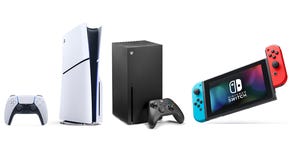eSports: Where are the big sponsors?
SuperData's Stephanie Llamas examines the booming eSports sector and why big brands should be getting on the bandwagon
Despite eSports' seemingly overnight success, they are a longstanding element of gaming and remain an untapped opportunity for advertisers to access a growing audience. That's because video games have transcended nerd culture and become mainstream with blockbusters like Kim Kardashian: Hollywood and Candy Crush Saga now rivaling traditional media channels. Digital games are currently a $65 billion industry and eSports have followed suit, reaching over 188 million people by the end of this year.
A lot of people don't get eSports, and that's understandable. If you're not a gamer, it's hard to see the appeal of watching a bunch of (mostly) guys sitting behind computers with a giant screen broadcasting their gameplay. But a lot of other people do see the appeal. Just ask Korea: the demand for eSports is so high they broadcast it across multiple TV channels. Brands like Red Bull, Coca-Cola and even liquified lifeforce Soylent are already on board, yet plenty of the old-school advertisers struggle to understand this cool new thing all the kids are talking about. But sooner or later, they will all have to wake up and smell the energy drinks, and this is why.
People like watching people play games, and there's the human history to prove it.
Modern eSports stem from a very long history of gaming spectatorship. As game designer and NYU Arts Professor Eric Zimmerman points out, "Games are perhaps the first designed interactive systems our species invented," and we have long loved watching people play them: One of the earliest recorded board games with an audience was Patolli, played by mesoamericans as early as 200 B.C.

And it hasn't been a huge leap from physical to digital games. Zimmerman likens complex board games like Chess and Go to "computers, machines for creating and storing numerical states. In this sense, computers didn't create games; games created computers."
The video game gods said, "Let there be eSports," and so there were arcades.
If you've seen the documentary The King of Kong: A fistful of quarters, not only do you know supervillains exist in real life, but also that arcade competitions have been around for quite some time. They even made it to TV sets: In 1982, Ted Turner's production company saw an opportunity to televise people playing on these newfangled things, and so began the TV show Starcade. There were other attempts at this in subsequent years but shortly after arcades gave way to Ataris (and then E.T. killed those), Nintendo came to the rescue of video games. However, their consoles and handhelds made video games a more solitary experience.
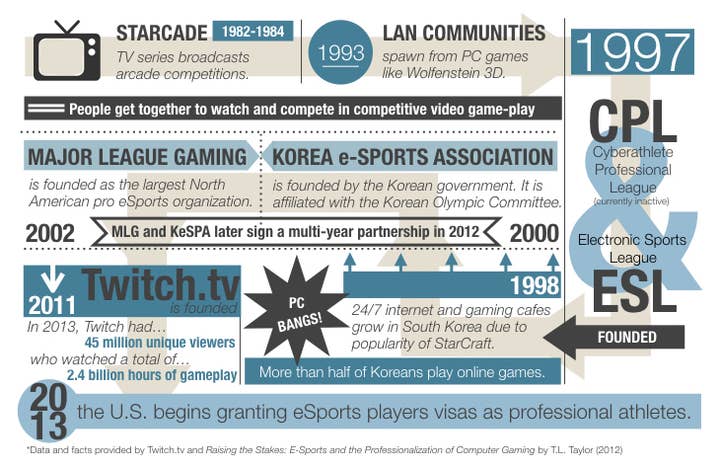
Fast forward to the early '90s and local area networks (LAN) begin connecting computers within a limited area, like a cybercafe - the mecca of gamers before the Internet. Players flocked to them at a time when many didn't have home desktops. LAN communities came together to play and watch games like Wolfenstein 3D, making gaming a group activity once again. As a way to formally organize tournaments, leagues formed like the now defunct Cyberathlete Professional League (CPL) and the still thriving Electronic Sports League (ESL) and Major League Gaming (MLG).
Meanwhile, Korea discovered StarCraft and thus began a passionate romance. The eSport became such a phenomenon that its government founded the Korea e-Sports Association (KeSPA) in 2000 as an offshoot of the Korean Olympic Committee Broadcast channels and then began televising competitions, turning eSports players into celebrities (just like "real" sports!).
Thanks to live streaming, the eSports audience is now almost three times larger than the population of South Korea.
South Korea may have been the pioneer of modern eSports, but its 51 million people have nothing on the 188 million who watch eSports globally. And we all have Twitch to thank - well, sort of. The live streaming site almost single-handedly catapulted eSports viewership to more than seven times what it was when the site launched in 2011. By offering a free and easy way for people to watch competitions, Twitch provided a medium for literally all the (digitally-capable) world to see the wonders of competitive gaming. Its imprint in gaming's history led to a $970 million acquisition by online media and retail conglomerate Amazon. A number of other platforms, including YouTube, have followed suit and are making eSports more accessible to an even wider audience.
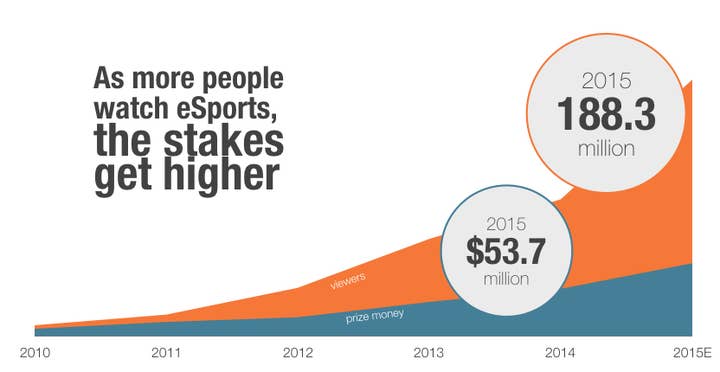
eSports viewers in the U.S. account for roughly a quarter of the 125 million Americans who watch gaming video content. The hard truth is younger audiences are increasingly cutting the cord, so the idea that broadcast TV will live forever is pretty much a fantasy by now. After Hulu and Netflix (which forced brick-and-mortar video rental behemoth Blockbuster out of business), HBO and Showtime have both jumped on board with streaming subscriptions. It makes a lot of sense when you consider almost 16 percent of American viewers ages 18-34 with broadband Internet do not have cable TV. That stat rises to 19 percent for gaming video content viewers and almost 25 percent for eSports viewers.
American eSports viewers are also really dedicated fans: they watch them on average four times a week for about an hour and a half each session. That's roughly six hours a week dedicated to just watching eSports. And when they aren't doing that, they are playing games: The average American fan plays every day for one to two hours. This means they really don't have a lot of time for cable TV, or any other non-gaming media for that matter.
The top eSports are digital games, and digital is the future of gaming.
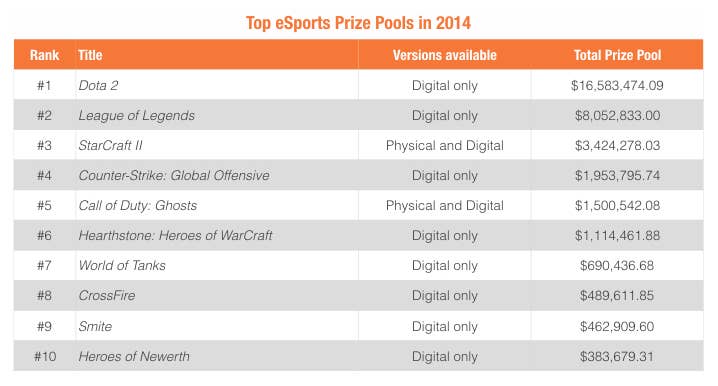
Spectators are coming out in droves to watch their favorite games, and those games continue to grow the digital gaming space. Digital-only League of Legends is arguably the biggest game and eSport in the world as it breaches $1 billion of revenue this year. 27 million unique viewers streamed the League of Legends World Championships last year, with a peak concurrent viewer base of 11 million and an average viewing session of over an hour. (As a comparison, the football game with the highest viewership this year, aside from the Super Bowl, was the College Football Championship, which drew 34 million viewers.) The game's publisher Riot began officially sanctioning tournaments in 2013 and since then, the game's annual revenue has increased 47 percent (CAGR of 14 percent) from $818.3 million to a whopping $1.2 billion.
Competitive gaming also helped Dota 2, the game with the largest prize pool of all time, make gains. Its biggest tournament The International is held each fall and a large portion of its prize pool is crowdfunded. As the pool increases every year, so does its gaming audience, showing a correlation between tournaments and its performance. This kind of increased user engagement on the eSports level is what will be driving more and more players to both flock to Dota 2 and to its events, creating a larger addressable audience for advertisers.
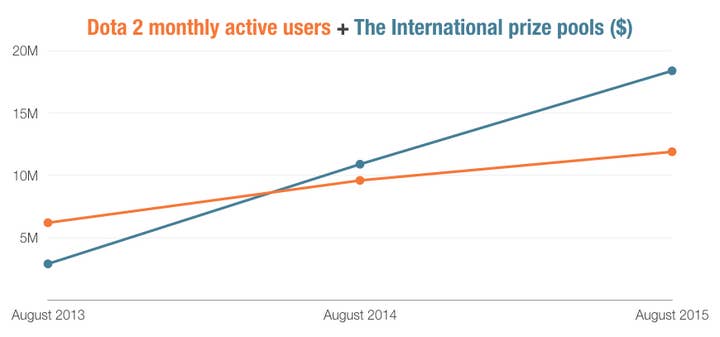
Since 2011 the worldwide games market has grown from $28.2 billion to $64.7 billion and digital games are outpacing traditional physical titles for big multi-platform publishers, and the industry as a whole. As digital trends upward, it has begun to overtake some seasonal retail sales and will eventually overtake the entire market.
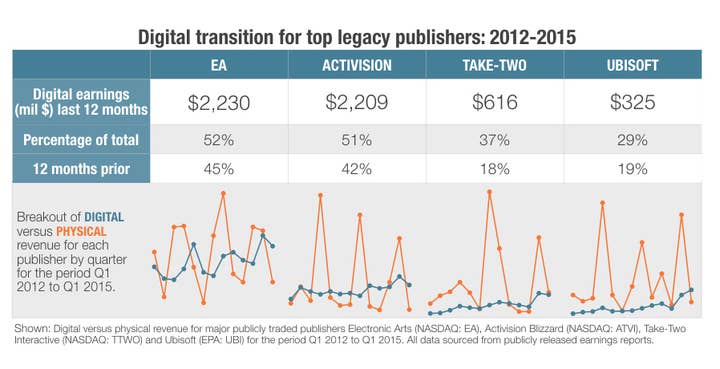
The future of eSports is coming and brands don't want to (and shouldn't) get left behind.
eSports broadcasts have gone beyond the traditional online channels and are extending to other platforms which has broadened audience diversity. Xbox One incorporated a Twitch app early on, with its players making up 22 percent of Twitch's total broadcast base in 2014. The console also offers MLG and ESL streaming apps. Sony's FOMO (fear of missing out) made them also add a Twitch streaming app this month.
This is all in addition to recent announcements that TBS and ESPN will be broadcasting upcoming tournaments. Now that eSports are breaking into broadcast TV, advertisers who were hesitant to experiment with new channels will take comfort in participating on a medium they are used to. Television advertising garners billions of dollars each year across all types of programming, so after brands look at Nielsen ratings and see the demographics these tournaments are targeting -- the elusive male audience age 14-35 -- many are sure to be salivating at the opportunity.
But consoles and television aren't the only platforms to get on board the eSports train: mobile is growing its stake in the space as well. Aside from apps by usual suspects Twitch, MLG and ESL, a number of eSports-dedicated mobile apps like TheScore eSports and Instant eSports have cropped up to provide fans with news, stats and live scoring coverage. This doesn't just serve zealous fans who are on-the-go - it provides a way for competitive games to reach more people. Since eSports already appeal to mid- and hardcore gamers, and this addressable audience will eventually max out, future growth will be increasingly contingent on the ability to recruit casual gamers' home turf.
Can mobile eSports ever be five times bigger than PC?
Speaking of mobile, a few titles have emerged that are changing the way pro-gamers play. Digital collectible card game Hearthstone: Heroes of Warcraft was released last year on PCs and tablets, and has since also launched on smartphones. Year-to-date, the game has earned $175 million and garnered 64 million monthly active players across platforms - a reason to turn it into an eSport. Hearthstone's World Championship final series boasted 135,000 concurrent viewers. Ok, so it's no League of Legends. And, fine, competitors play on PCs. But the game has a larger mobile following which will likely be the key demographic for future competitions. Its smartphone version also had the third most watched commercial on YouTube in July (1.6 million viewers) according to AdWeek, which means they see an opportunity to put a lot of money into advertising and helping both their player base and eSports viewership grow.
Hearthstone isn't the only mobile game to make its way into eSports: mobile Multiplayer Online Battle Arena (MOBA) Vainglory was specifically designed for eSports. Publisher Super Evil Megacorp thinks touchscreen eSports are the future: COO Kristian Segerstrale says, "In three years' time, there will only be 600 or 700 million home PCs capable of running the highest-spec PC games, yet there will be 2.5 or 3 billion devices capable of running Vainglory. That's why the touchscreen eSports opportunity will be maybe five times larger than the PC eSports opportunity today." Tactile mechanics may shake up the eSports world and provide a casual audience a way into competitive gaming. It also has the potential to overtake "twitch" games, extending the lifetimes of pro players since they do not require quick reflexes to play.
Virtual Reality will (literally) bring eSports into your living room.
Everyone is psyched about VR. The co-founder of id Software John Carmack, who brought us the pixelated wonders that were DOOM and Castle Wolfenstein, left his own company to join VR innovator Oculus. Then Zuckerberg thought Oculus was so cool he scrounged up some change from his very deep pockets and acquired it for a cool $2 billion. Sony, now raging with FOMO created its own headset dubbed PlayStation VR (formerly Morpheus). All this VR foreplay is leaving some to wonder what the big bang will look like. Google Maps, museums, therapy programs - a whole slew of possibilities are emerging and it's only natural that games would be at the forefront.
Virtual Arenas are how people like Oculus CEO Palmer Luckey see VR changing eSports. "You can feel like you're there with your friends," he says. "I think that will change how eSports works when you can have lots of people watching in a virtual environment." That means advertising and sponsorships during matches could be broadcast to the millions of fans who "attend." And brands will be able to target their advertisements by showing certain eBillboards and commercials to their brands' key demographics (that means no more L'oreal commercials, boys!)
So... where are all the sponsors?
That's something a lot of us video game folks want to know. After all, why wouldn't brands jump on board this booming industry if so many people are watching? Just Google eSports and hundreds of articles 'oohing' and 'ahhing' its seemingly out-of-nowhere emergence pop up because this is big, and it's only getting bigger. Brands need to realize this is something special and it's here to stay - well, at least millions of us nerds think so.
Stephanie Llamas is Director, Research and Consumer Insights at SuperData. For more information on the eSports market, download SuperData's eSports Update Market Brief 2015/2016.








